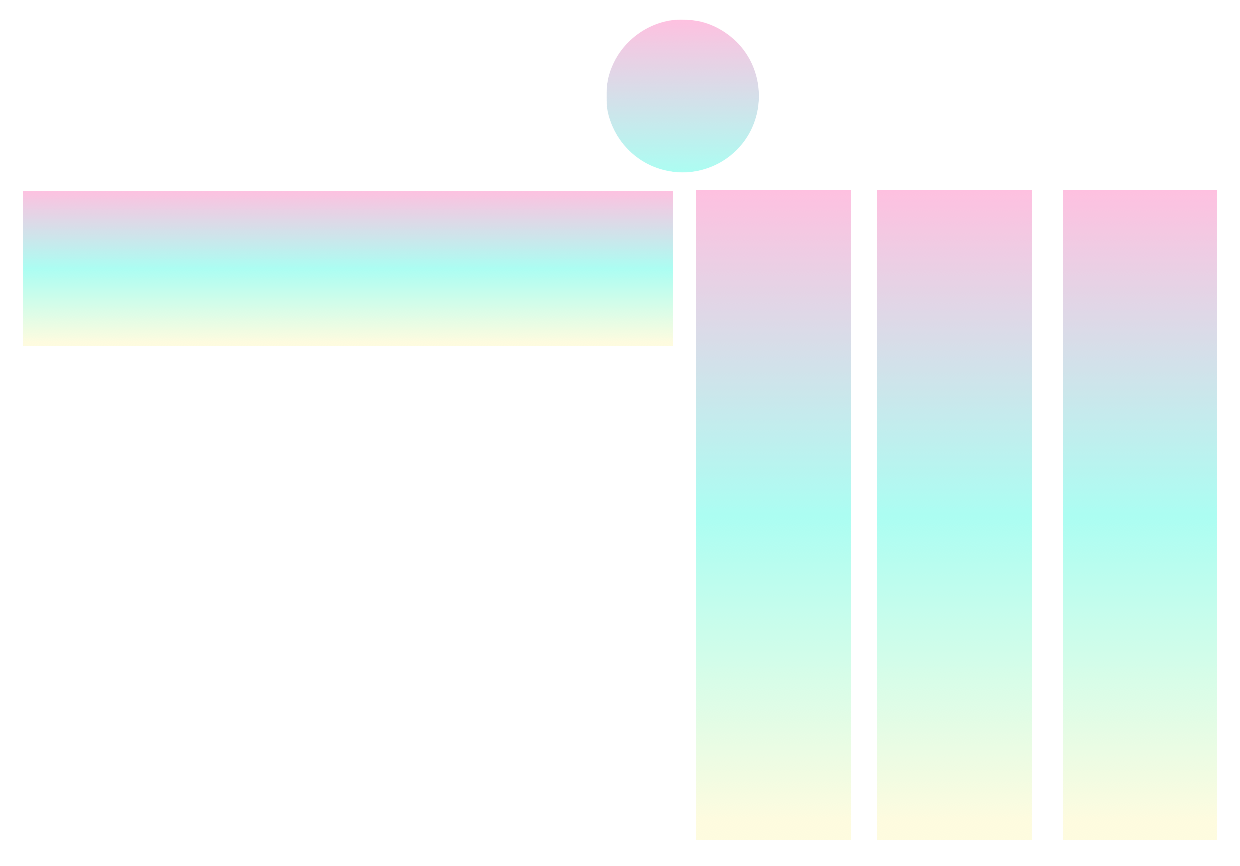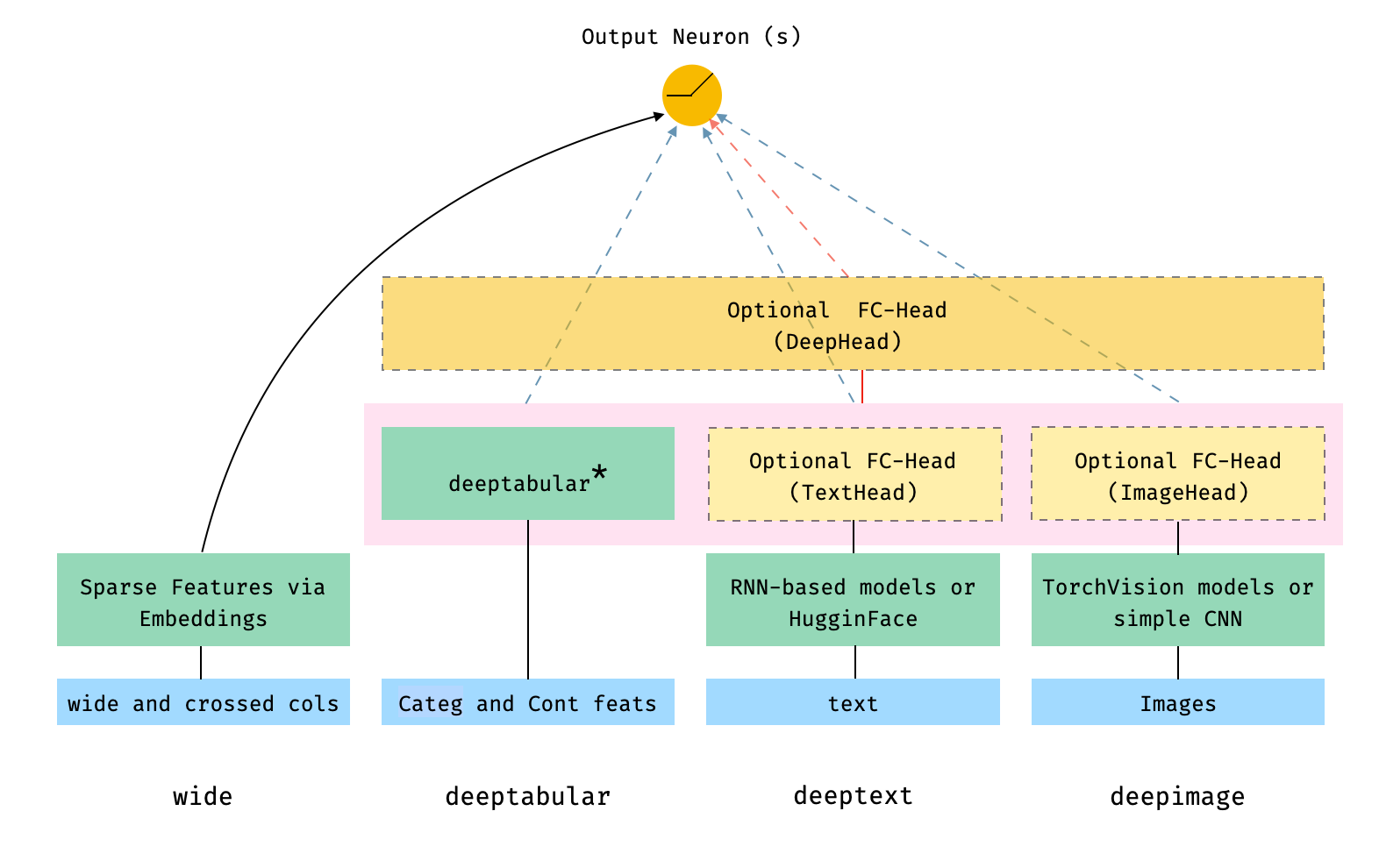jrzaurin / Pytorch Widedeep
Programming Languages
Projects that are alternatives of or similar to Pytorch Widedeep
pytorch-widedeep
A flexible package to use Deep Learning with tabular data, text and images using wide and deep models.
Documentation: https://pytorch-widedeep.readthedocs.io
Companion posts: infinitoml
Introduction
pytorch-widedeep is based on Google's Wide and Deep Algorithm, Wide & Deep
Learning for Recommender Systems.
In general terms, pytorch-widedeep is a package to use deep learning with
tabular data. In particular, is intended to facilitate the combination of text
and images with corresponding tabular data using wide and deep models. With
that in mind there are a number of architectures that can be implemented with
just a few lines of code. The main components of those architectures are shown
in the Figure below:
The dashed boxes in the figure represent optional, overall components, and the
dashed lines/arrows indicate the corresponding connections, depending on
whether or not certain components are present. For example, the dashed,
blue-lines indicate that the deeptabular, deeptext and deepimage
components are connected directly to the output neuron or neurons (depending
on whether we are performing a binary classification or regression, or a
multi-class classification) if the optional deephead is not present.
Finally, the components within the faded-pink rectangle are concatenated.
Note that it is not possible to illustrate the number of possible
architectures and components available in pytorch-widedeep in one Figure.
Therefore, for more details on possible architectures (and more) please, see
the
documentation,
or the Examples folders and the notebooks there.
In math terms, and following the notation in the
paper, the expression for the architecture
without a deephead component can be formulated as:
Where 'W' are the weight matrices applied to the wide model and to the final activations of the deep models, 'a' are these final activations, and φ(x) are the cross product transformations of the original features 'x'. In case you are wondering what are "cross product transformations", here is a quote taken directly from the paper: "For binary features, a cross-product transformation (e.g., “AND(gender=female, language=en)”) is 1 if and only if the constituent features (“gender=female” and “language=en”) are all 1, and 0 otherwise".
While if there is a deephead component, the previous expression turns
into:
It is important to emphasize that each individual component, wide,
deeptabular, deeptext and deepimage, can be used independently and in
isolation. For example, one could use only wide, which is in simply a linear
model. In fact, one of the most interesting functionalities
inpytorch-widedeep is the deeptabular component. Currently,
pytorch-widedeep offers 3 models for that component:
-
TabMlp: this is almost identical to the tabular model in the fantastic fastai library, and consists simply in embeddings representing the categorical features, concatenated with the continuous features, and passed then through a MLP. -
TabRenset: This is similar to the previous model but the embeddings are passed through a series of ResNet blocks built with dense layers. -
TabTransformer: Details on the TabTransformer can be found in: TabTransformer: Tabular Data Modeling Using Contextual Embeddings
For details on these 3 models and their options please see the examples in the Examples folder and the documentation.
Finally, while I recommend using the wide and deeptabular models in
pytorch-widedeep it is very likely that users will want to use their own
models for the deeptext and deepimage components. That is perfectly
possible as long as the the custom models have an attribute called
output_dim with the size of the last layer of activations, so that
WideDeep can be constructed. Again, examples on how to use custom
components can be found in the Examples folder. Just in case
pytorch-widedeep includes standard text (stack of LSTMs) and image
(pre-trained ResNets or stack of CNNs) models.
Installation
Install using pip:
pip install pytorch-widedeep
Or install directly from github
pip install git+https://github.com/jrzaurin/pytorch-widedeep.git
Developer Install
# Clone the repository
git clone https://github.com/jrzaurin/pytorch-widedeep
cd pytorch-widedeep
# Install in dev mode
pip install -e .
Important note for Mac users: at the time of writing (Feb-2020) the latest
torch release is 1.7.1. This release has some
issues
when running on Mac and the data-loaders will not run in parallel. In
addition, since python 3.8, the multiprocessing library start method
changed from 'fork' to
'spawn'.
This also affects the data-loaders (for any torch version) and they will not
run in parallel. Therefore, for Mac users I recommend using python 3.6 or
3.7 and torch <= 1.6 (with the corresponding, consistent version of
torchvision, e.g. 0.7.0 for torch 1.6). I do not want to force this
versioning in the setup.py file since I expect that all these issues are
fixed in the future. Therefore, after installing pytorch-widedeep via pip or
directly from github, downgrade torch and torchvision manually:
pip install pytorch-widedeep
pip install torch==1.6.0 torchvision==0.7.0
None of these issues affect Linux users.
Quick start
Binary classification with the adult
dataset
using Wide and DeepDense and defaults settings.
Building a wide (linear) and deep model with pytorch-widedeep:
import pandas as pd
import numpy as np
from sklearn.model_selection import train_test_split
from pytorch_widedeep import Trainer
from pytorch_widedeep.preprocessing import WidePreprocessor, TabPreprocessor
from pytorch_widedeep.models import Wide, TabMlp, WideDeep
from pytorch_widedeep.metrics import Accuracy
# the following 4 lines are not directly related to ``pytorch-widedeep``. I
# assume you have downloaded the dataset and place it in a dir called
# data/adult/
df = pd.read_csv("data/adult/adult.csv.zip")
df["income_label"] = (df["income"].apply(lambda x: ">50K" in x)).astype(int)
df.drop("income", axis=1, inplace=True)
df_train, df_test = train_test_split(df, test_size=0.2, stratify=df.income_label)
# prepare wide, crossed, embedding and continuous columns
wide_cols = [
"education",
"relationship",
"workclass",
"occupation",
"native-country",
"gender",
]
cross_cols = [("education", "occupation"), ("native-country", "occupation")]
embed_cols = [
("education", 16),
("workclass", 16),
("occupation", 16),
("native-country", 32),
]
cont_cols = ["age", "hours-per-week"]
target_col = "income_label"
# target
target = df_train[target_col].values
# wide
wide_preprocessor = WidePreprocessor(wide_cols=wide_cols, crossed_cols=cross_cols)
X_wide = wide_preprocessor.fit_transform(df_train)
wide = Wide(wide_dim=np.unique(X_wide).shape[0], pred_dim=1)
# deeptabular
tab_preprocessor = TabPreprocessor(embed_cols=embed_cols, continuous_cols=cont_cols)
X_tab = tab_preprocessor.fit_transform(df_train)
deeptabular = TabMlp(
mlp_hidden_dims=[64, 32],
column_idx=tab_preprocessor.column_idx,
embed_input=tab_preprocessor.embeddings_input,
continuous_cols=cont_cols,
)
# wide and deep
model = WideDeep(wide=wide, deeptabular=deeptabular)
# train the model
trainer = Trainer(model, objective="binary", metrics=[Accuracy])
trainer.fit(
X_wide=X_wide,
X_tab=X_tab,
target=target,
n_epochs=5,
batch_size=256,
val_split=0.1,
)
# predict
X_wide_te = wide_preprocessor.transform(df_test)
X_tab_te = tab_preprocessor.transform(df_test)
preds = trainer.predict(X_wide=X_wide_te, X_tab=X_tab_te)
# save and load
trainer.save_model("model_weights/model.t")
Of course, one can do much more. See the Examples folder, the documentation or the companion posts for a better understanding of the content of the package and its functionalities.
Testing
pytest tests
Acknowledgments
This library takes from a series of other libraries, so I think it is just fair to mention them here in the README (specific mentions are also included in the code).
The Callbacks and Initializers structure and code is inspired by the
torchsample library, which in
itself partially inspired by Keras.
The TextProcessor class in this library uses the
fastai's
Tokenizer and Vocab. The code at utils.fastai_transforms is a minor
adaptation of their code so it functions within this library. To my experience
their Tokenizer is the best in class.
The ImageProcessor class in this library uses code from the fantastic Deep
Learning for Computer
Vision
(DL4CV) book by Adrian Rosebrock.







